The Ortona Christmas dinner is a significant event in the history of the Canadian regiments who fought in Ortona in December 1943 and Lieutenant Terry Rowe’s photograph of men seated in the open, and eating their Christmas dinner in 1943 has become the evidence of that event. Media was becoming increasingly visual at the start of the Second World War with newsreels shown in cinemas, and with photographs printed in newspapers and magazines. The work of the cameramen of Canadian Army Public Relations was to provide the photographic proof for these visual media. The scene of the Christmas dinner even appears as cine footage in “Canada at War: Road to Ortona” (1962). While the camera captures a true image of a moment in time, what actually happened in that moment still depends on the provenance of the image: the who, what, where, when, why, and how it was made. What a photograph captures depends on the documentation we have and how consistent is it with what we see in the frame.
The famous photograph, and matching cine footage, is not of the Christmas dinner at the church of Santa Maria di Constantinopoli, but in the town of Marina di San Vito some five and a half kilometres to the south. The original captions made by the photographer, Terry Rowe, are unambiguous and the evidence in his photos only confirm this fact. The details in Rowe’s captions are wholly consistent with the all other documents made at the time.
Part of the confusion was that several Christmas dinners were recorded around Ortona. In an article published by the Gazette of Montreal describes at least four dinners, two of which were recorded by Canadian Army photographers. Marcel Ouimet made a broadcast of yet more Christmas celebrations in Italy with “Silent Night” being sung at a hospital. Another Christmas dinner for the journalists and cameramen of Canadian Army public relations camp in San Vito photographed by Lieutenant Fred Witcombe. Every unit involved in the battle of Ortona recorded details of how they celebrated that Christmas. Not surprisingly there are many details that are in agreement among these documents including the identities of individual. The soldiers, photographers, and journalists alike who authored these documents shared the revolutionary idea that stories of the ordinary individuals, no matter how humble, deserved to be told.
The article from Canadian Press printed in the Gazette which describes both the dinner at the church of Santa Maria di Constanopoli and the dinner in Marina di San Vito. The article also describes a dinner with the Royal Canadian Service Corps photographed by Fred Witcombe (frame 28102) which is sometimes also used to illustrate the dinner at Santa Maria de Constantinopoli. All journalism made during the war come with challenges, first being they are often intentionally vague due to operational censorship. Such censorship would exclude any information that might be useful to the Germans such as the names of formations and their location. It is not obvious on the first reading of article in the Gazette that it is describing several different Christmas dinners. Ouimet’s broadcast of Christmas carols is evocative, but none of it describes the dinner in Santa Maria Constantinopoli. What he does have of Ortona on Christmas are the sounds of battle.
The famous photo in question is found on Terry Rowe’s roll 71. That roll has nine negatives in a square format on 120 film, frames 28029 to 28037, that record the same Christmas dinner in 1943. There are only nine frames of a possible twelve on the roll likely because he simply advanced the film past the first and last frames. These frames on a roll of 120 film are vulnerable to light leaks and such light leaks would spoil any photographs in those places. Better to waste the frames than take an unusable photograph.
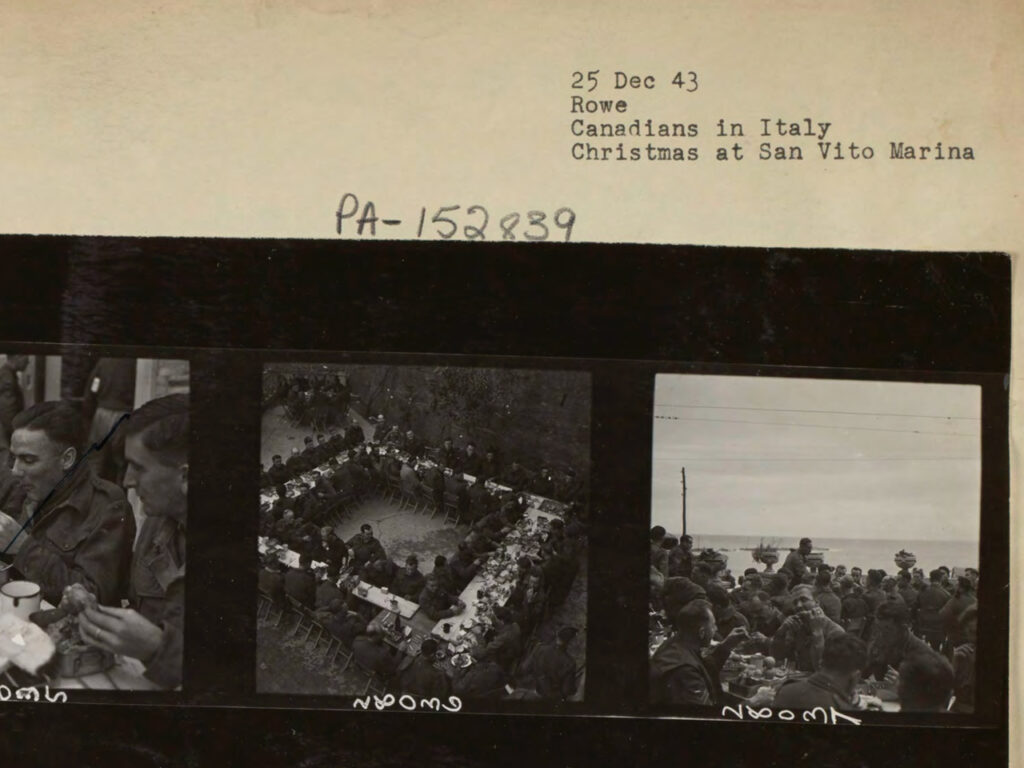
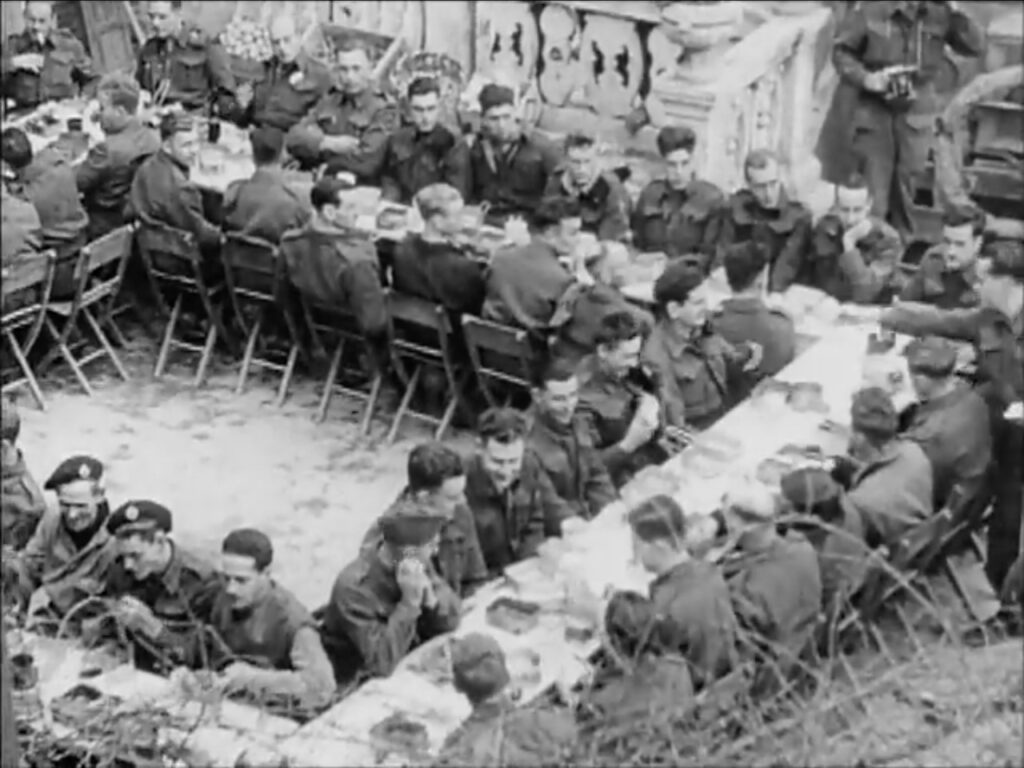
Frame 28036 is the famous photograph. The negative shows that the photo is often cropped to remove a small table by the balustrade at the upper left corner. The orientation of the patio is easily deduced because the ocean can be seen in frames 28033 and 28037. No mater where on the Adriatic coast these photos were taken, the ocean will always be to the east. The south side of the patio is at the bottom of a massive curved retaining wall can be seen in the famous photograph. Interestingly the man serving in frame 28031 and frame 28037 is Lieutenant Houser who is also mentioned in the article appearing in the Gazette. The west side is shown in frame 28032. Here we see a sign that reads “Caffe e Vino” which makes this explicitly not a religious space, so nothing like the oratory next to Santa Maria di Constantinopoli. Frame 28033, with a view of the ocean, shows what appears to be a canvas cover to a lorry just below the balustrade, suggesting there is a road just below the patio.
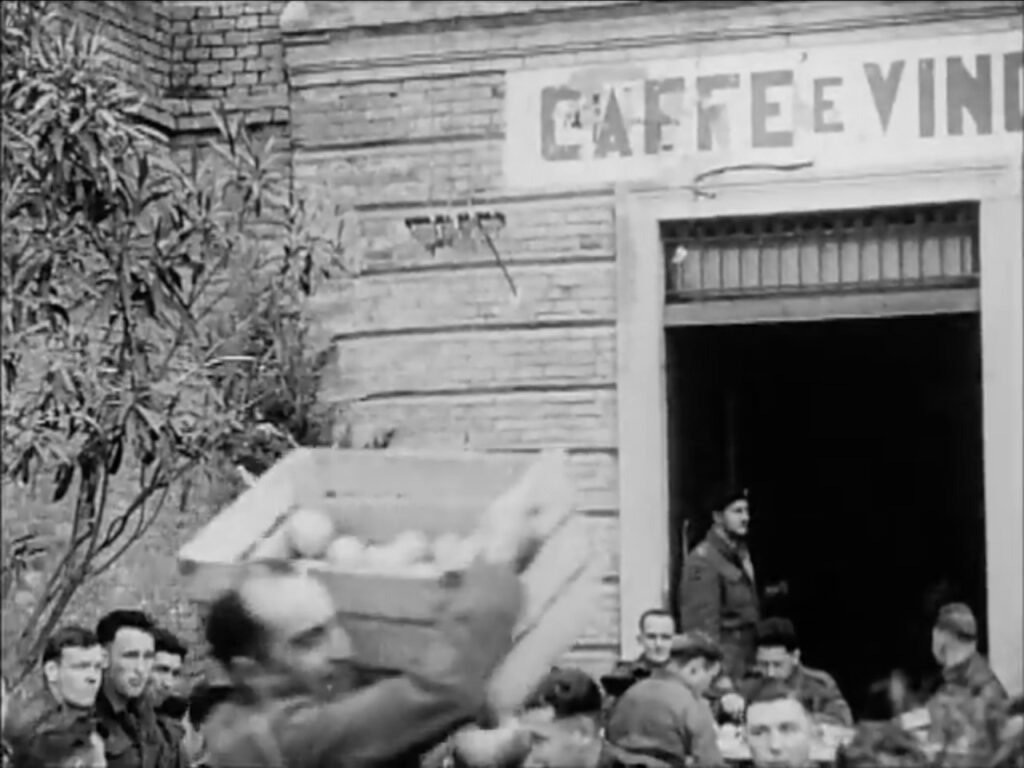
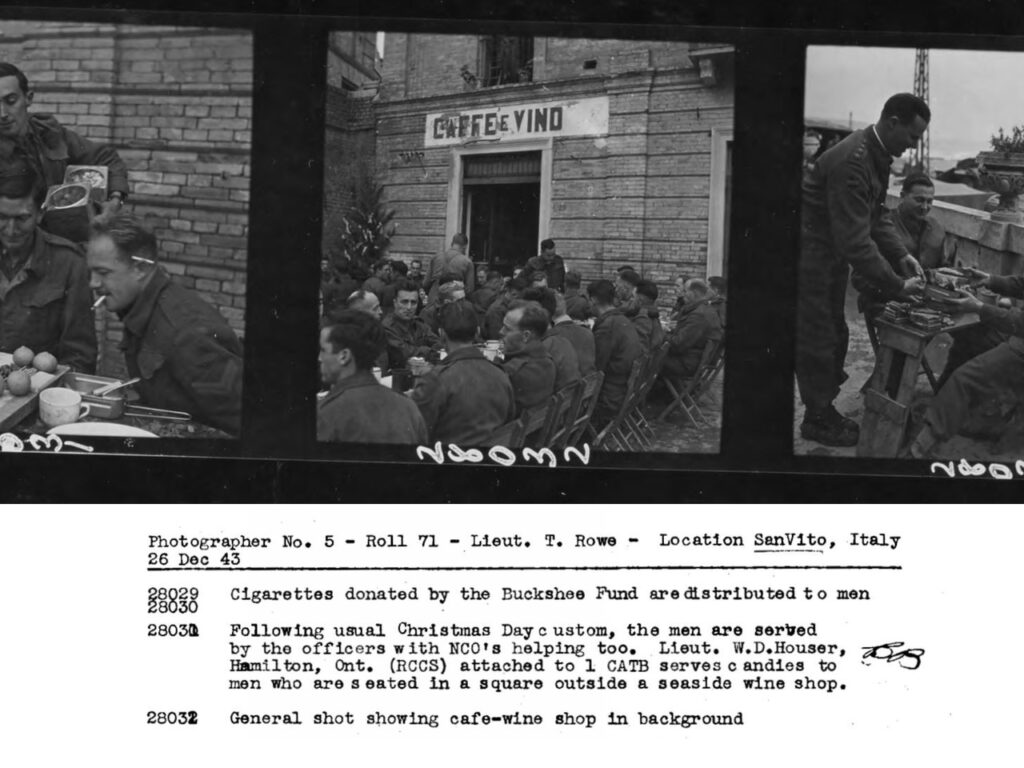
Amazingly in “Canada at War”, several shots in the cine footage repeats similar framing of the same subjects to the photos taken by Terry Rowe on his roll 71. Norm Quick recalled filming the scene and how Rowe did not want to climb the height to get an overhead view. There is also a photo of Quick having a drink with fellow cine cameraman E.C. “Andy” Anderson in San Vito overlooking the Adriatic. They are both leaning against a balustrade just like the one in shown on Rowe’s Roll 71 and the matching cine footage seen in “Canada at War”.
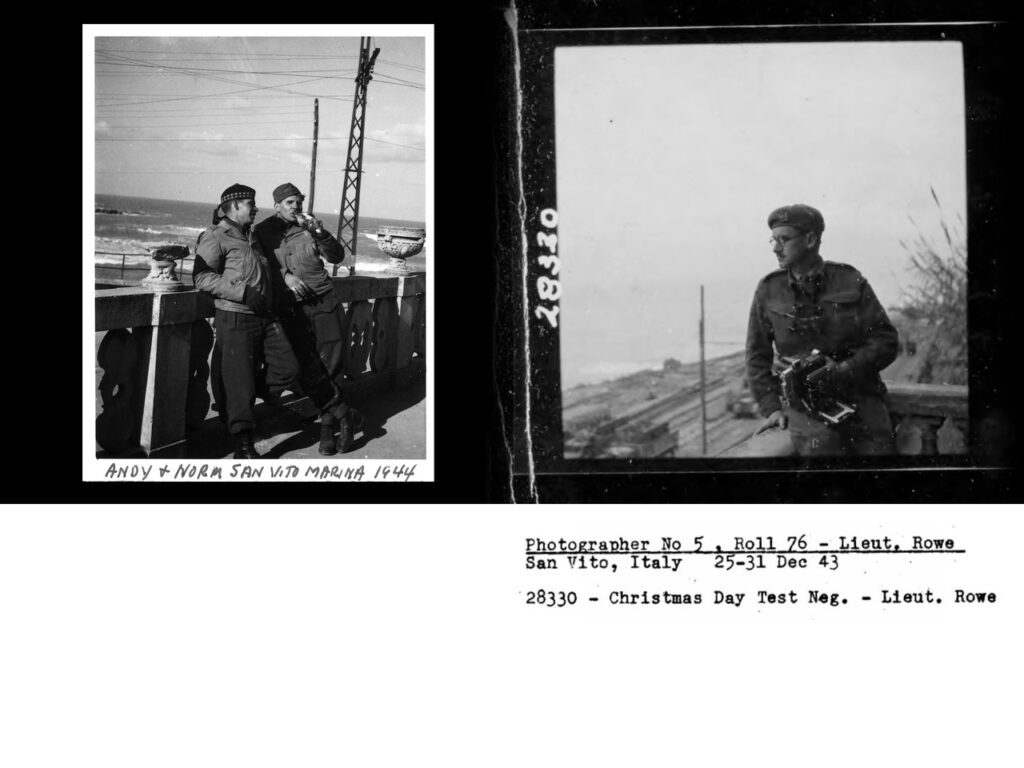
I believe most of the patio was demolished in to make way for the Via Nazionale Adriatica, the SS16 highway, built in 1973. What would have been a right angle from the Via Frentana to the coast road was rounded into a curve, trimming off the corner where the patio was. While there are no buildings exactly like the one shown in Rowe’s famous photograph in San Vito today, the overall landscape is consistent with the location of the Trattoria Adriatica. The restaurant still has a smaller patio overlooking the sea and a massive retaining wall to the south. The details of the space are different, but many decades have passed since Christmas 1943 and much has been rebuilt.
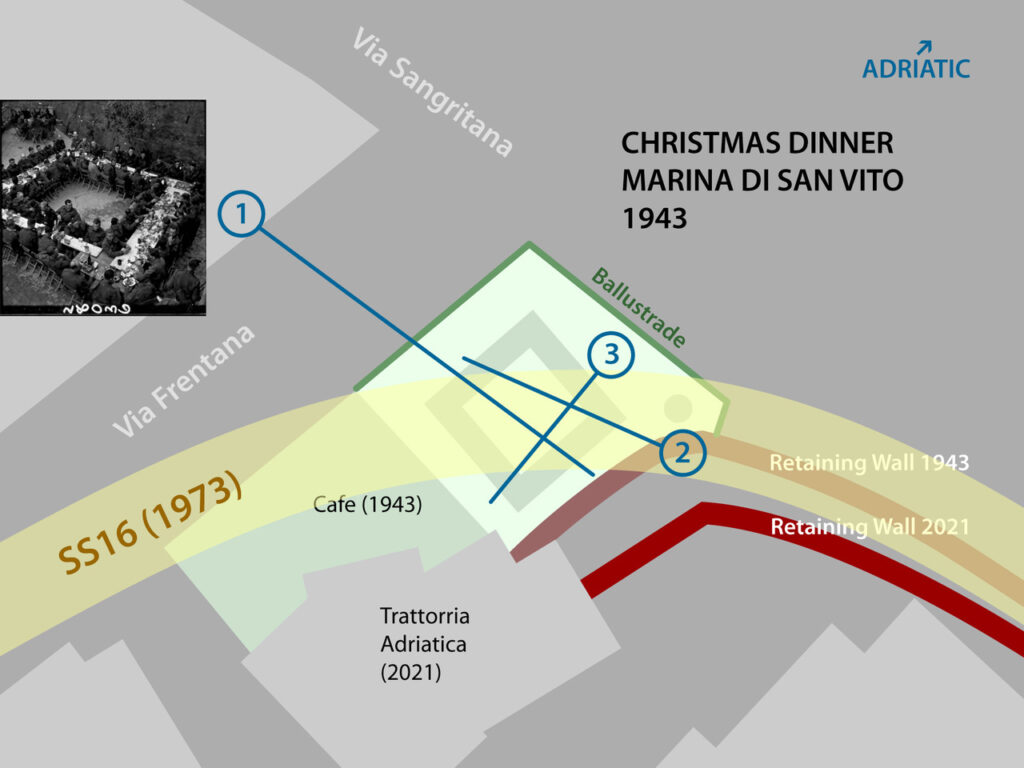
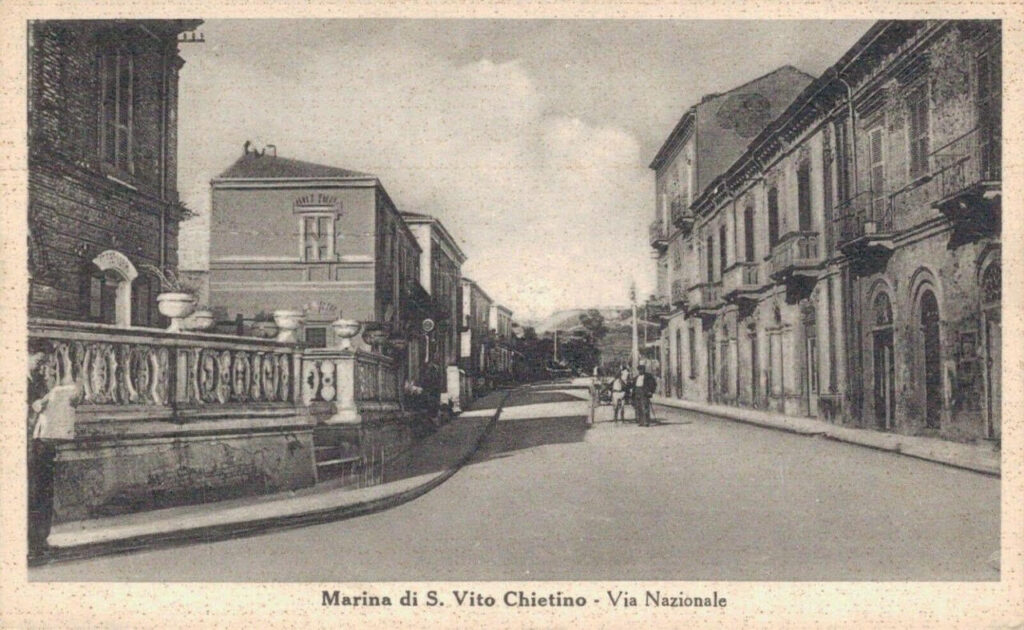
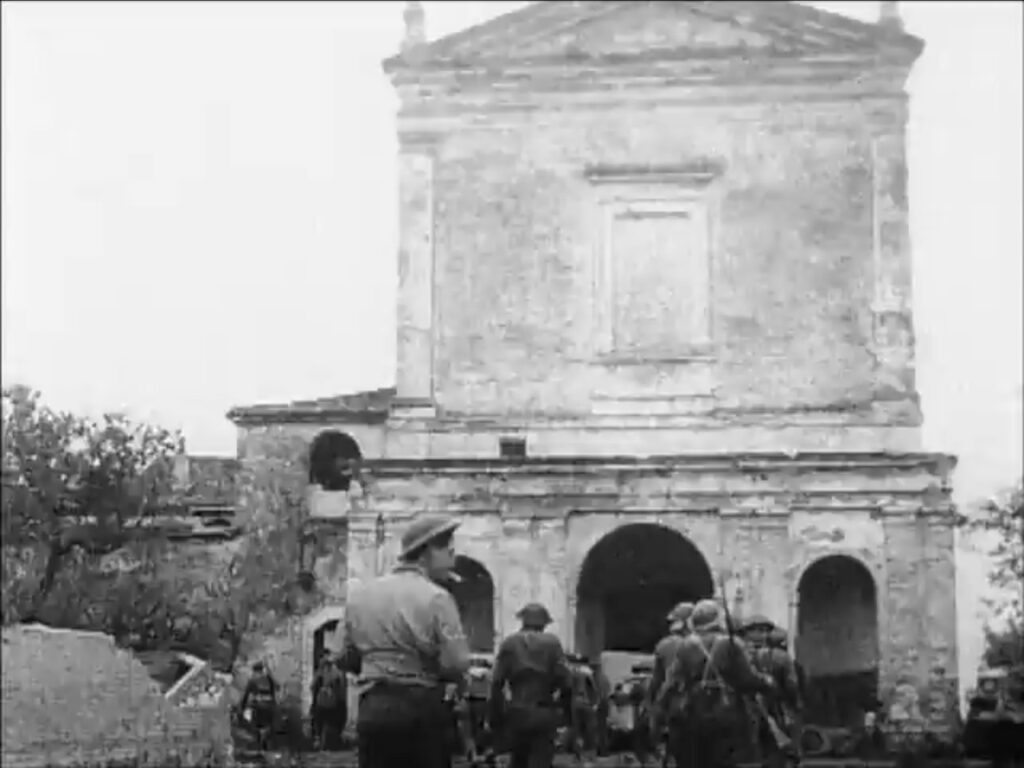
With so many men seated outside, the patio in these photographs is unlikely to be anywhere near Santa Maria Constantinopoli in Ortona as the whole area around the church was well within range of German mortars. The Gazette article notes that during one of the Christmas dinners, “mortar shells fell nearby”. The church of Santa Maria Constantinopoli had already been targeted by the Germans before. One of Rowe’s photographs, frame 29972, taken on 22 December shows vehicles of the Seaforth Highlanders in flames by the church after being struck by German mortars. That regiment’s war diary reports that this happening at 10:30 AM with one bomb striking the roof of the church. It would have still been reckless to allow solders to group together in the open anywhere in Ortona on the 25 December. If the patio had a nice view of the harbour, then anyone in the harbour would have a nice view of the patio. We know the Germans were in the harbour of Ortona because the Headquarters Squadron of the Three Rivers Regiment were using their guns against the German dug into the cliff facing the harbour of Ortona the day after Christmas.
The dinner for many of the Seaforths was full of anxiety. Ernest “Smokey” Smith thought it was an unnecessary risk and did not attend. Each company took turns going to the church. Two people who have been claimed to be in the photograph, Ernie Bagstad and Jock Gibson as part of ‘D’ Company would be the last group and would not have made their way to the church unit 6 PM, an hour and a half after sundown. Without sunlight, cinematographic technology of the era required powerful artificial lights. The film was just not sensitive enough. The Canadian Army Film Unit used Kodak XX which is rated around 100 ISO. Bagstad and Gibson would have arrived at the church in the dark to enjoy the two short hours of peace allotted to each company. Captain D.B. Cameron, the quartermaster organizing the dinner, was so alarmed by the light from inside that was visible through the holes in the roof that he had the candles in the church extinguished. The church did not suffer a barrage of mortar bombs or artillery that day as feared and the last of ‘D’ Company returned to battle with twenty fresh replacements.
How did the famous photograph, Rowe’s frame 28036, become associated with the Christmas Dinner in Ortona despite the original files being so explicit? The most likely reason is the CBC production “Canada at War”. I have yet to find the image being used before then, let alone with the suggestion that the event photographed took place in Ortona. It was not included in the Canadian Army Newsreel 24.3 “Battle of Ortona” (1944) nor was it included in Fred Witcombe’s book “The Photographic History of the Canada’s Army Overseas 1939-1945” (1947). The Canada at War series epitomizes the poetic licence editors take with war footage by swapping images from one event to illustrate another. A practice that is still considered fair in documentaries. Back in 1962, eye witnesses were still available, so no one doubted the reality of the events. A little fudging on the provenance of the imagery did little damage to the credibility of the production.
When the war ended, most soldiers just wanted to go home and when they finally returned they found their friends and family could not relate to what they had experienced, so they did their best to forget what had happened. For many of these eye witnesses, the original broadcast of “Canada at War” in 1962 was the first time they would have recalled their time in uniform. Images have an enormous effect on memory. If you show someone a picture of them smiling at a birthday party then most will recall that birthday as a happy one. Show a picture of a Christmas dinner in Marina di San Vito to veterans while recounting their Christmas dinner in Ortona, that picture can become their memory.
The claim that one of those in the famous photograph is William Challan, as the face third from the top left corner looking into the camera, may well be true as Challan was not taken on strength by the Seaforths until 27 December. He could well have been in San Vito on Christmas Day before joining ‘A’ Company. During the weeks before his records have him on the extended list for the Perth Regiment. He had only arrived in Italy on 13 November and would last only one month with the Seaforths. His death, as it was for many, was just bad luck when a German mortar bomb struck too close to his slit trench.
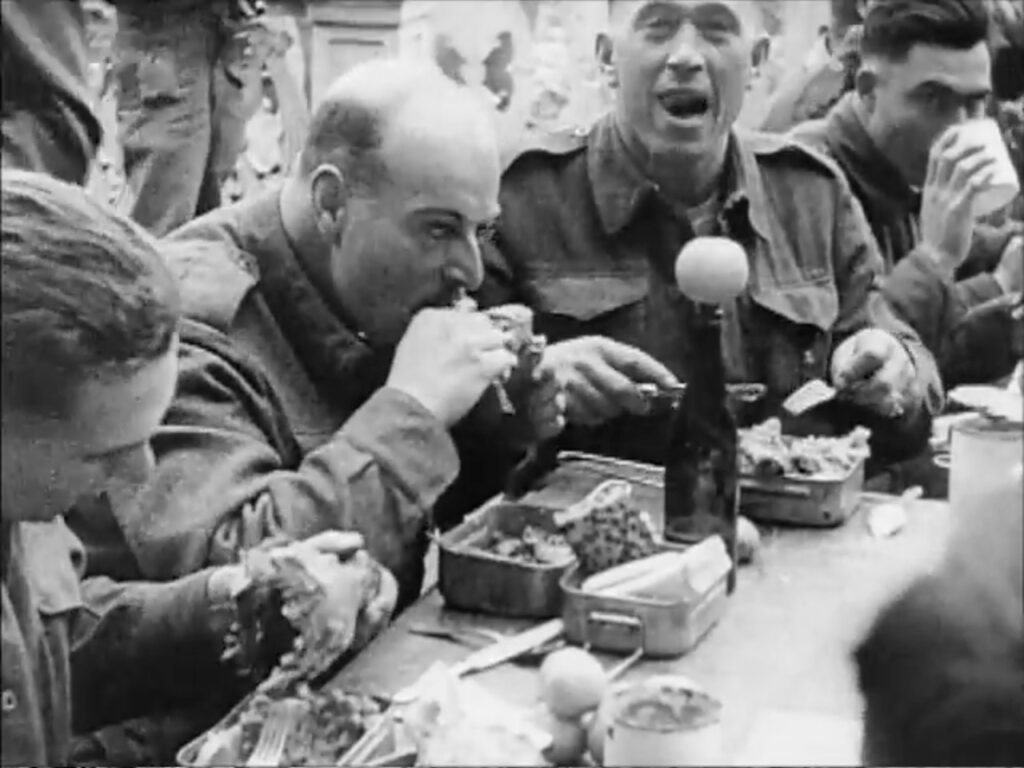
The man who took the famous photograph, Terry Rowe, had been killed in action at Anzio so could not be consulted. The carefully compiled dope sheets written by those who shot the footage used in the series, like Norm Quick, were often ignored. Their work was just so much stock footage to be stripped from their context and plundered for its dramatic effect. A situation that only got worse after the NFB fire of 1967 that destroyed not just the original footage, but most of the documentation. For the younger generation, there was nothing new to be said about the Second World War. That history was over and done with, so not worthy of real investigation. “Canada at War” is a speech given at the burial of the past, but the past often refuses to remain buried.
There are a few images of the church of Santa Maria di Constantinopoli taken on 21 and 22 December. Those taken on 21 December show it while it was the Seaforth Highlanders of Canada’s ‘C’ Company headquarter briefly on 21 December. It would become battalion headquarters hours later and remained so through Christmas Day. Rowe’s notes on his frame 27956 showing the front face of the church has a hand written addition, “was Seaforth’s Coy HQ – Xmas Dinner”. The church, with its portico made of three arches, appears again on 22 December with Seaforth’s vehicles parked next to it in flames. The fighting in days following Rowe’s photographs of the church must have been devastating as the building has been stripped of the neoclassical facade. Today the church is little more than plain brick box.
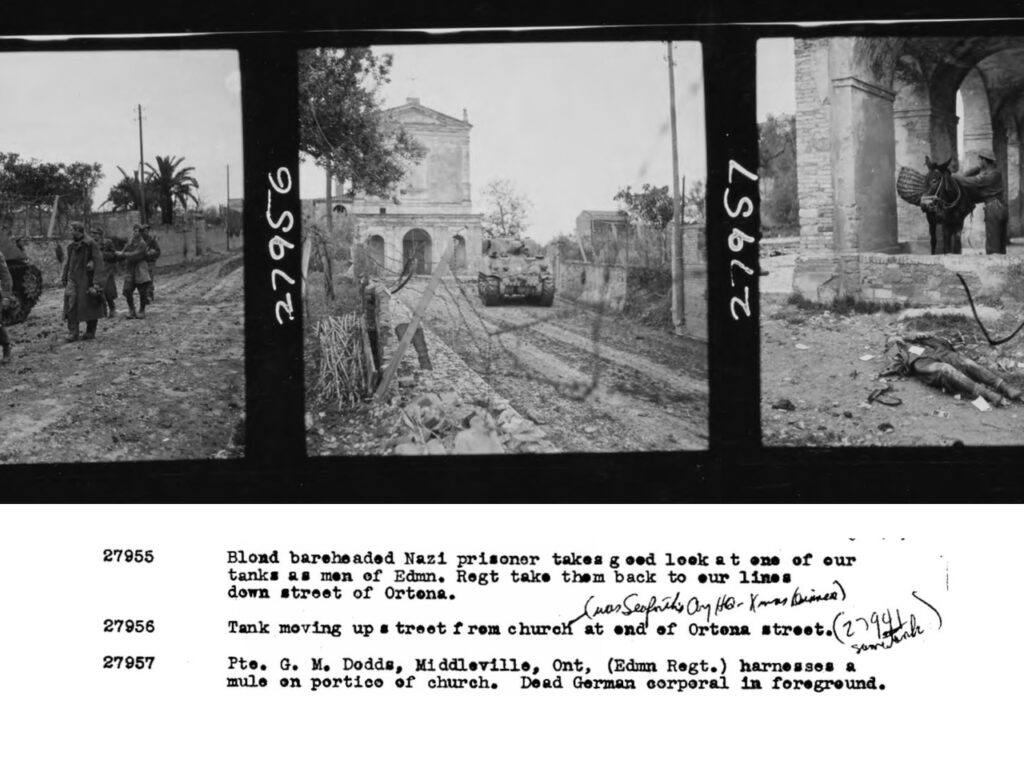
Frustratingly, among the quick cuts of “Canada at War: The Road to Ortona” does actually show soldiers walking towards the church of Santa Maria Constantinopoli. It is one among several other pieces of cine footage taken during the Battle of Ortona that also match Rowe’s photographs taken on the 21 and 22 December. Lieutenant photographers and sergeant cine cameramen were teamed together and consistently have the same subjects similarly framed in their work. Many of the other clips intercut around these scenes shown in “Canada at War: the Road to Ortona” are from unrelated events: training films, the battle of Cassino, Christmas 1944, and so on. Sadly we have lost the original footage from the Canadian Army Film Unit along with most of their documents so we may never be able to fully disentangle this mess of images in “Canada at War”.
The patron saint of Ortona is Thomas the Apostle, the Doubting Thomas, who would not believe Christ’s resurrection until he touched the wound in the side of Christ as he stood before him. Modern theologians have noted that Thomas’s demand for evidence could never be fully satisfied given the fundamental problem of empiricism. Our search for certainly can leave us unable to believe in anything. His belief that it was Christ before him was no less of an act of faith than the first to believe, Mary Magdalene. His doubt and his touching of Christ’s wound was a foolish exercise in avoiding the truth.
The Christmas dinner at the church of Santa Maria di Constantinopoli happened and its meaning will remain intact so long as we remember it. Whether the images of the dinner we use to illustrate that event are of that event has nothing to do with the truth of the event. By gathering together for a Christmas feast, those Canadians experiencing the worst of war committed an act of faith that peace would return. An act of faith that took place in a shattered city far from home in 1943.
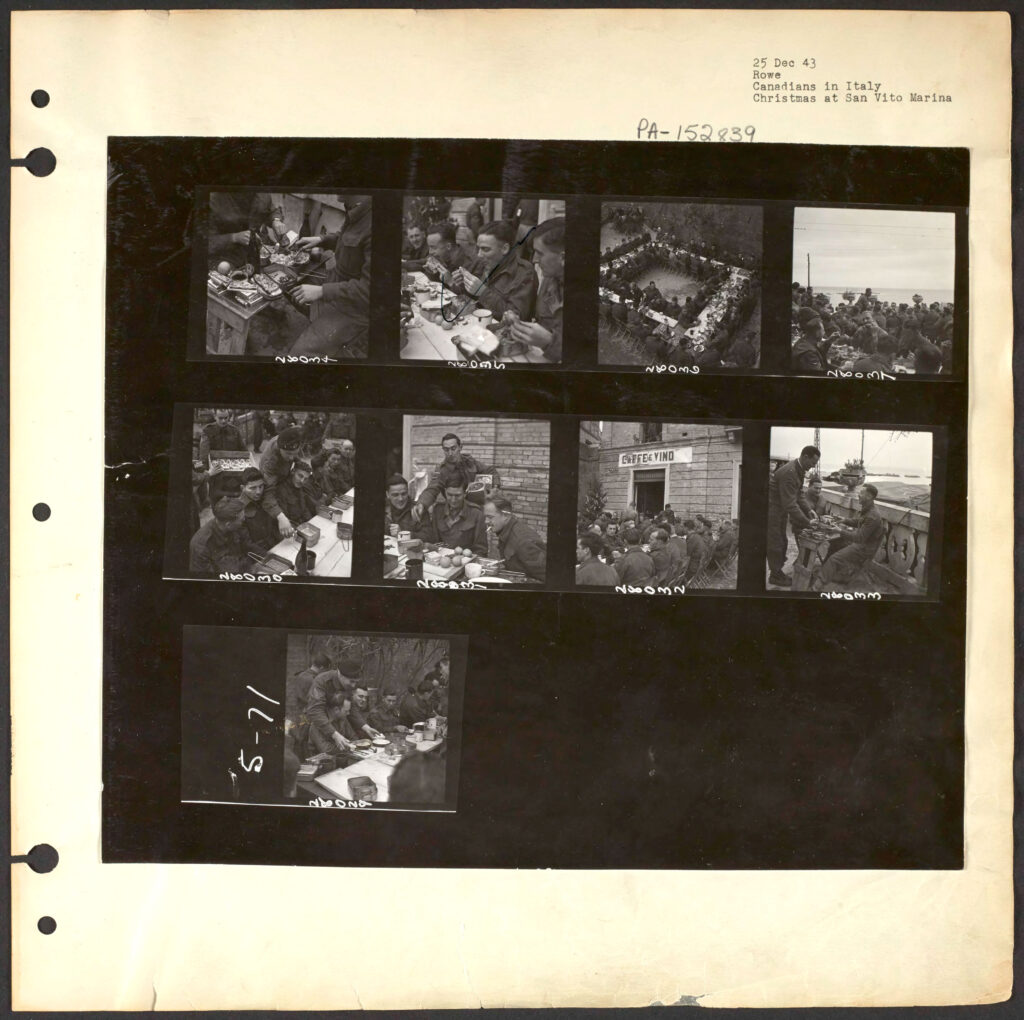
Captions, Volume 66, page 41
28029 Cigarettes donated by the Buckshee Fund are distributed to men
28030
28031 Following usual Christmas Day custom, the men are served by the officers with NCO’s helping too. Lieut. W.D.Houser, Hamilton, Ont. (RCCS) attached to 1 CATB serves candies to men who are seated in a square outside a seaside wine shop.
28032 General shot showing cafe-wine shop in background
28033 The padre Hon-Capt. Joseph Wilhelm, MC, Hamilton, Ont.
R.C. padre for 1 CATB serves heaping mess tins of turkey, cake,
etc. to Tpr. E. Phiffeault (left) of Shawinigan Falls, Que.,
and Pte. L.A. Como (R) of Morinville, Alta. Pte. Como is with the RCASC attached to 1 CATB
28034 CU of two Christmas dinners as served to two men in picture 28033 showing oranges, candy, nuts, cigarettes, etc.
28035 L/Cpl. H. A. Willson, Moose Jaw, Sask., (L) bites into turkey while his guest (R) of Tpr. C. D. Jones of Nottingham, Eng.
a visiting British Army trooper, does likewise without
ceremony
28036 General view of Brigade HQ at Christmas dinner (other ranks
only)
28037 Same as 28036 showing Adriatic in background, with Lieut.
Houser serving.“
© Ben Moogk 2021






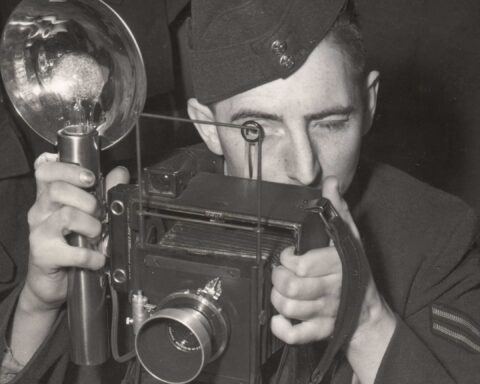



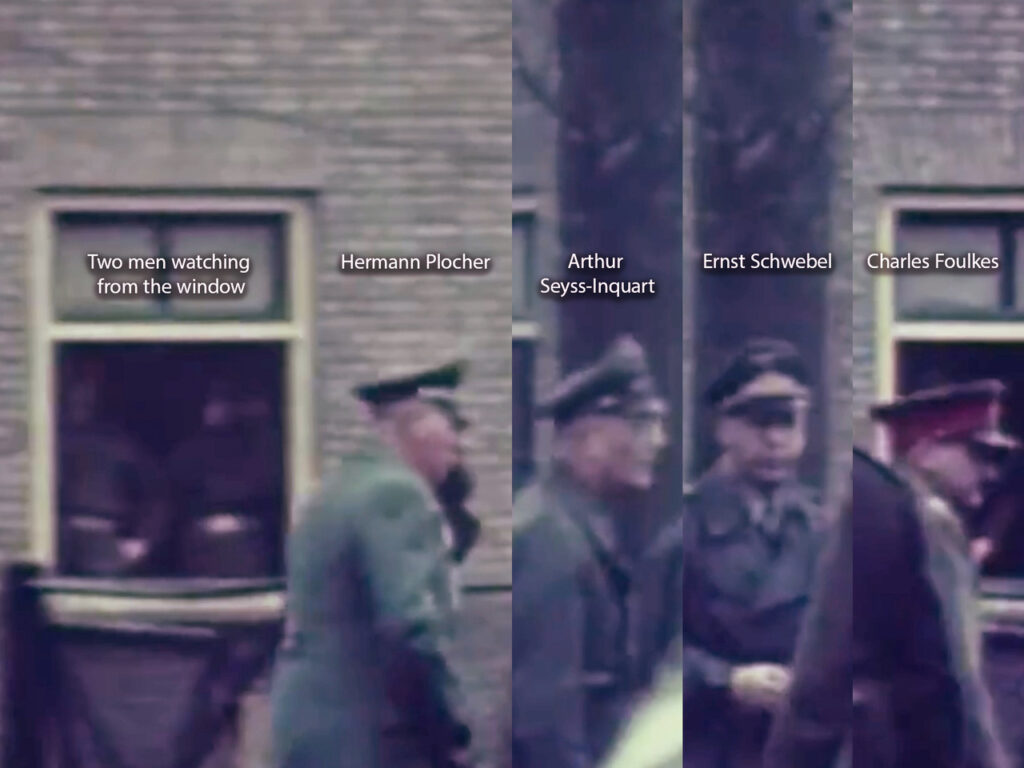
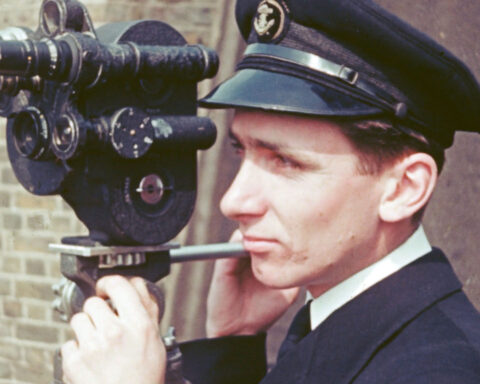
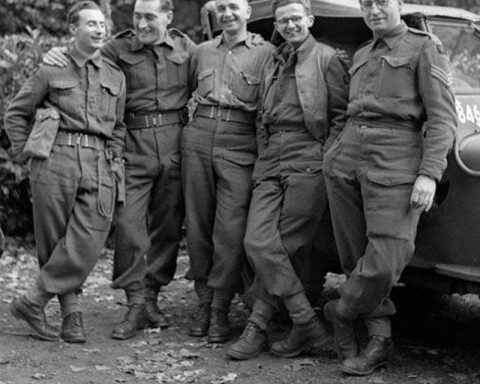

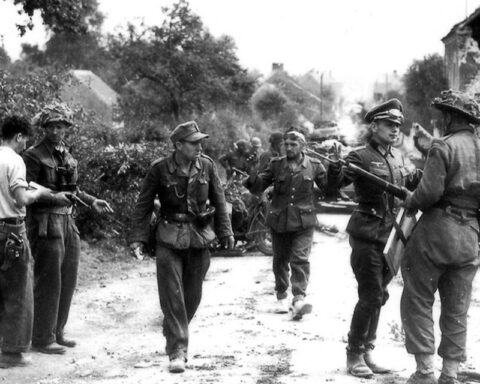

Thank you for this information! My father (Private Hector N. Paul) served with the Seaforths. And was in Ortona. One of our treasured moments is the Order of Service for the Chaplain’s service in Ortona, Dec 29, 1943 just as they prepared for the battle for the town.
Hi Noreen – thank you very much for sharing!
I must refute the statement that the famous Terry Rowe photograph of the Christmas Dinner was not taken in Ortona. It was most certainly taken in Ortona and if you care to visit, I will take you to the very spot.
H Angela – thank you very much for the feedback. I will forward your comment to the author for further discussion.
The Christmas Dinner at the Church of Santa Maria di Constantinopoli for the Seaforths was a particularly poignant event that should be remembered. The church was filmed and photographed on 21 and 22 December, but not on Christmas. Rowe’s own notes on his roll 71 of a Christmas dinner are explicit about it being at the marina of San Vito Chientino. There were several Christmas dinners, and each left its own record. Using Rowe’s photographs of one Christmas dinner to represent the dinner at the Church of Santa Maria di Constantinopoli is a misrepresentation of just how much of an effort it was to celebrate despite the dangers in Ortona. This is not the only time a photograph of one event during the war has been using to represent another. Better to use the evidence we can rely on. The first person accounts by the Seaforths of the dinner at Santa Maria di Constantinopoli show a much more grim reality than we see in Rowe’s photographs. Those at San Vito were no base walas. Terry Rowe would be killed in action. Cine cameraman “Andy” Anderson, a Seaforth, would be pierced through the chest by a shell splinter while filming.
Please yourself. I have several eye-witness accounts of veterans who identified themselves in that photo and they were definitely in Ortona. And what does the death of Terry Rowe have to do with this? Terry Rowe didn’t die in Ortona. Or the splinter in the chest of Andy Anderson? Does that affect where ONE of those TWO photos were taken? We’re not talking about how horrific Ortona may or may not have been. As an Ortona resident who has talked in depth with veterans and civilian survivors of the battle I have a reasonably graphic idea of what happened. And FYI, the church courtyard is set sheer above the sea so anyone eating there would have the sea in the background.
A very interesting article Ben with many thought provoking points. I still remain convinced the Christmas Dinner photo was indeed taken in Ortona at the church of Santa Maria di Constantinopoli. I had a conversation with Norman Quick before he died confirming that he was in fact the photographer of that photo at the dinner in Ortona. As you point out, Terry Rowe was nervous about climbing the balcony to take the shot from above. As recounted by Norm, he grabbed Terry’s camera, jumped up to the position on the balcony, took one shot and jumped back down again handing Terry back his camera. The photo was never accredited to Norm because it was on Terry’s camera roll. You may be interested to read my article with my own research and conclusions about that photo: https://mural.themilitarymuseums.ca/ortona-dinner
Ben thank you for clarifying the contentious issue surrounding the dinner and this picture.
I happen to agree with you for purely tactical reasons, the soldiers in the picture are clean, shaved and do not have any tactical kit at hand.
The Seaforths were very much still in the fight and would not have lounged around like those in the picture. Additionally they came straight from the fight and were dirty and unshaven, unlike these fellows.
Cheers
Mark Lundie
CWO, RSM
Seaforth Highlanders of Canada
My father (35th LAA Battery) was in Ortona during this Christmas 1943, and he told me that they were not included in any of these celebration dinners, in fact, he said he didn’t remember getting anything special … I would imagine only so many CDN soldiers would have been able to be included.
Thanks for sharing this Gord. Dale.